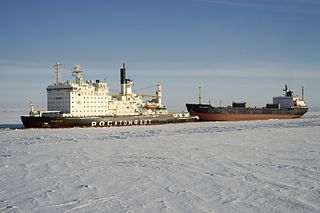
An icebreaker is a special-purpose ship or boat designed to move and navigate through ice-covered waters, and provide safe waterways for other boats and ships. Although the term usually refers to ice-breaking ships, it may also refer to smaller vessels, such as the icebreaking boats that were once used on the canals of the United Kingdom.

A nuclear-powered icebreaker is a nuclear-powered ship, purpose-built for use in waters covered with ice. The only country constructing nuclear-powered icebreakers is Russia. Nuclear-powered icebreakers have been constructed by the Soviet Union and later Russia primarily to aid shipping along the Northern Sea Route in the frozen Arctic waterways north of Siberia. Nuclear-powered icebreakers are much more powerful than their diesel-powered counterparts, and although nuclear propulsion is expensive to install and maintain, very heavy fuel demands and limitations on range, compounded with the difficulty of refueling in the Arctic region, can make diesel vessels less practical and economical overall for these ice-breaking duties.
Taymyr or Taimyr may refer to:
A nuclear navy, or nuclear-powered navy, refers to the portion of a navy consisting of naval ships powered by nuclear marine propulsion. The concept was revolutionary for naval warfare when first proposed. Prior to nuclear power, submarines were powered by diesel engines and could only submerge through the use of batteries. In order for these submarines to run their diesel engines and charge their batteries they would have to surface or snorkel. The use of nuclear power allowed these submarines to become true submersibles and unlike their conventional counterparts, they became limited only by crew endurance and supplies.

The Arktika class is a Russian class of nuclear-powered icebreakers. Formerly known as Project 10520 nuclear-powered icebreaker, they were the world's largest and most powerful icebreakers until the 2016 launch of the first Project 22220 icebreaker, also named Arktika. Ships of the Arktika class are owned by the federal government, but were operated by the Murmansk Shipping Company (MSCO) until 2008, when they were transferred to the fully government-owned operator Atomflot. Of the ten civilian nuclear-powered vessels built by Russia, six have been of this type. They are used for escorting merchant ships in the Arctic Ocean north of Siberia as well as for scientific and recreational expeditions to the Arctic.
The KLT-40 family are nuclear fission reactors originating from OK-150 and OK-900 ship reactors. KLT-40 were developed to power the Taymyr-class icebreakers and the LASH carrier Sevmorput. They are pressurized water reactors (PWR) fueled by either 30–40% or 90% enriched uranium-235 fuel to produce 135 to 171 MW of thermal power.

Arktika is a retired nuclear-powered icebreaker of the Soviet Arktika class. In service from 1975 to 2008, she was the first surface ship to reach the North Pole, a feat achieved on August 17, 1977, during an expedition dedicated to the 60th anniversary of the October Revolution.
Soviet naval reactors have been used to power both military and civilian vessels, including:

Taymyr is a shallow-draft nuclear-powered icebreaker, and the first of two similar vessels. She was built in 1989 for the Soviet Union in Finland, at the Helsinki Shipyard by Wärtsilä Marine, by order of the Murmansk Shipping Company. Her sister ship is Vaygach.
Seven ships of the French Navy have borne the name Astrolabe, after the instrument astrolabe

The Taymyr was an icebreaking steamer of 1200 tons built for the Russian Imperial Navy at St. Petersburg in 1909. It was named after the Taymyr Peninsula.

Icebreaker Vaygach was an icebreaking steamer of moderate size built for the Russian Imperial Navy at St. Petersburg in 1909. She was named after Vaygach Island in the Russian Arctic.

Vaygach is a shallow-draught nuclear-powered icebreaker. She was built in 1989 for the Soviet Union by Wärtsilä Marine Helsinki Shipyard in Finland by order of the Murmansk Shipping Company. Her sister ship is Taymyr.

CCGS John G. Diefenbaker is the name for a Canadian Coast Guard icebreaker that had been expected to join the fleet by 2017 but has been significantly delayed. Her namesake, John G. Diefenbaker, was Canada's 13th prime minister. It was Diefenbaker's government that founded the Canadian Coast Guard in 1962.

A river icebreaker is an icebreaker specially designed to operate in shallow waters such as rivers and estuaries, and often able to pass through canals and under bridges. As published by the American Society of Civil Engineers almost a century ago, "On some rivers, particularly where melting first takes place on the upper river, as on the Oder and Weichsel in Germany, the formation of ice jams is a frequent cause of floods." River icebreakers can operate in any navigable waterway to prevent such ice jams.
Two ships have been named Sibir and one has been laid with planned same name:
Two ships have been named Arktika, Russian for the Arctic:
Two icebreakers have been named Vaygach:
Three icebreakers have been named Georgiy Sedov:
Two icebreakers have been named Rossiya, romanization of the Russian language word for "Russia" (Россия):
This page is based on this
Wikipedia article Text is available under the
CC BY-SA 4.0 license; additional terms may apply.
Images, videos and audio are available under their respective licenses.








